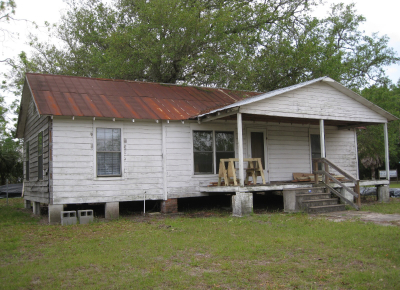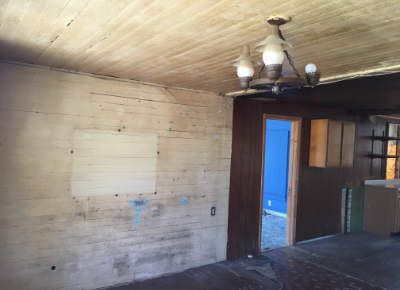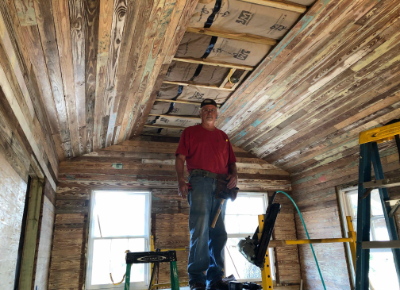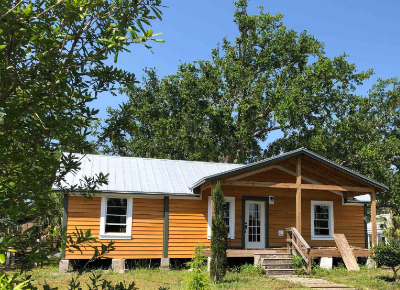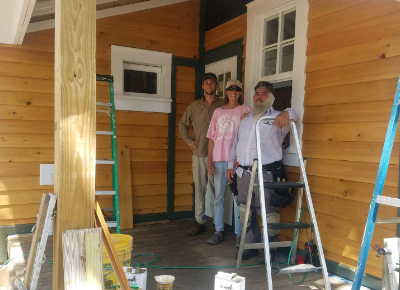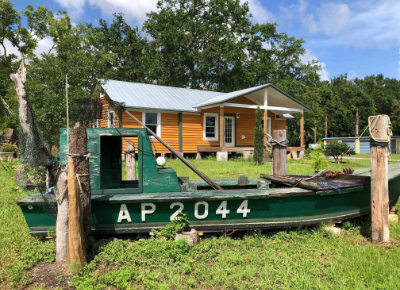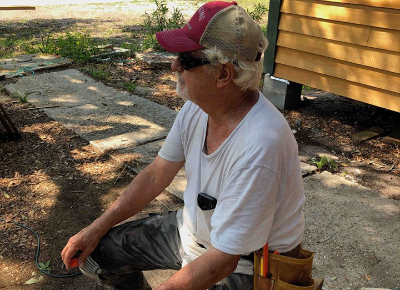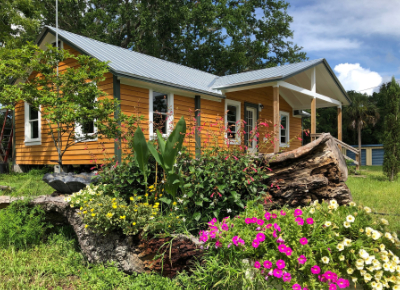
About Us
In April of 2018, gallery owners, Andrea Comstock and Brian O’Meara, were fortunate to purchase a small house on a quarter-acre of land at the edge of Apalachicola’s commercial downtown district. At the rear of the house sat a magnificent live oak tree with massive branches that encompassed the house. One of its branches rested comfortably on the roof of a faded red tin shed. We knew it was meant to be. Thus, began our endeavor to restore the house—originally built in the 1930s—and honor its history, while at the same time beginning a new chapter: an art gallery devoted to nature and wildlife subjects.
We moved to Apalachicola in 2014 after 30 years in the Florida Keys. Andrea worked as an arts administrator with the Florida Keys Council of the Arts for over 10 years, assisting artists with grants and other opportunities, until becoming director of the Key West Art Center, a community art gallery with roots stretching back to the 1930s WPA era. Now, along with managing Live Oak Gallery, she kayaks the creeks and marshes every chance she gets. Brian is a light tackle charter boat captain who grew up hunting and fishing in and around Lake Charles, Louisiana. He is the one behind the careful restoration of the gallery building.
Live Oak Gallery is built to be an inviting space full of wood and natural light where artists and their audience can discover each other. Along the way, we hope, through art, to increase awareness and support for the preservation of our natural environment - particularly here, in the place we are grateful now to call home.
The Apalachicola Bay, River and floodplain with its pine forests, wetlands and coastal marshes is one of the most productive, resource-rich estuaries in the northern hemisphere. This estuary - where fresh and saltwater meet - is an extraordinary ecosystem: home to over a hundred species of fish, and a sanctuary for nesting bald eagles and loggerhead sea turtles, migratory birds, and more species of native plants and animals than any comparable region in the country.
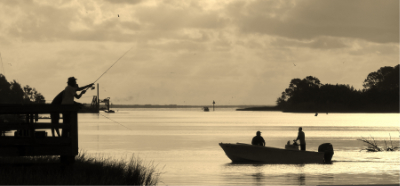
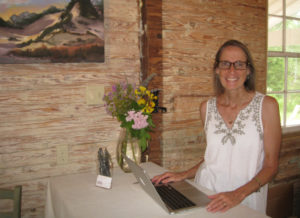
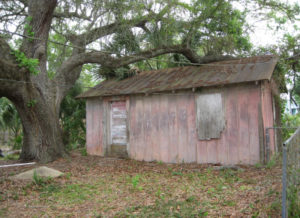
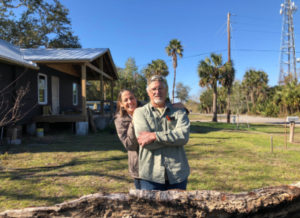
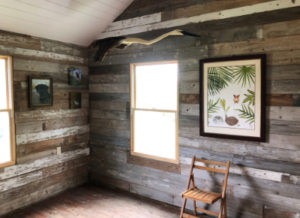
The Renovation
Following a year of restoration work, Live Oak Gallery opened its doors in the fall of 2019. Even so, the property is (and probably always will be) a work in progress. A more detailed photo presentation about the project is on display at the gallery.
A History of the House & Neighborhood
For years, this wood frame house at the corner of Market Street and Avenue G has commanded a sweeping view of Apalachicola’s north end commercial district known as the Bowery. The neighborhood was a bustling area for the seafood, lumber and shipping industries from the mid-19th century until the Depression era.
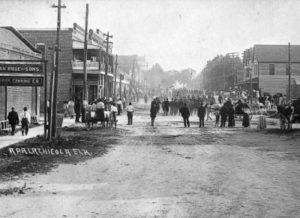
View Down Market Street
Alongside numerous oyster and shrimp houses, prominent industrial businesses during that time included the Crystal Ice and Power Company, operating in the brick buildings on Water Street (where the Apalachicola Ice Company is today), as well as the Cypress Lumber Company, located where Scipio Creek Marina is now. Ruge Brothers Canning Company on Market Street started out as a hardware and machine shop before becoming Florida’s first successful commercial seafood packer. It was George Ruge and his brothers who led the drive to secure local railroad service for delivering lumber, oysters and fish to northern markets, as it was more reliable than river transport.
“Apalachicola’s first railroad engine steamed into town on April 30, 1907 amid a town-wide celebration,” according to the history pages of the City of Apalachicola website. “The Apalachicola Northern Railroad track entered town at the north end of Market Street and ran parallel along Water Street to its terminus at the Railroad Depot located near Commerce Street and Avenue G.”
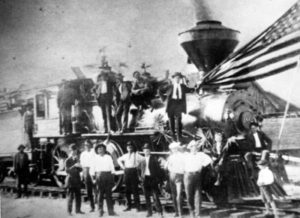
Apalach Northern Train
The railroad depot, just one block from this house, provided a steady stream of customers for neighborhood businesses—notably the Riverside Café, located directly across Avenue G from the depot at Water Street, and Nichols Economy Cash Store, also directly across from the depot at Commerce Street—all within view of our front porch. Both businesses were owned by brothers John and Constantine Nichols, enterprising Greek immigrants who bought the two adjacent lots and constructed the buildings in 1914.
The history section of the Franklin County website tells us: “The Economy Cash Store thrived, supplying groceries, dry goods, notions and patent medicines. People from up the river arriving on the train in Apalachicola to take care of business would frequently stop in at the Economy Cash Store and place their order before heading into town. Then they would pick up the order on their way back to the station to board the train home. Sometime before 1931, a poured concrete building was built in the space between the Riverside Café and the Nichols Economy Cash Store. This became the Ladies Tea Room... reserved exclusively for ladies.”
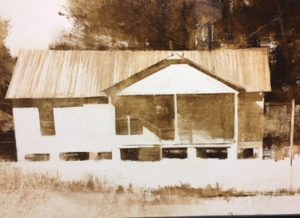
Christo's House by Charlie Hunter
It was around this time, in the 1930s, that the original 700-square-foot structure of this house came into existence. A 235-square-foot addition was built onto the south side around 1948. The house is described in Florida’s Department of History and Archives Master Site File as “a one-story frame vernacular house with drop siding, a cross gable on the east side and a covered front porch.” Its only exterior ornament: “exposed rafter ends and corner boards. Interior walls were of tongue and groove pine.”
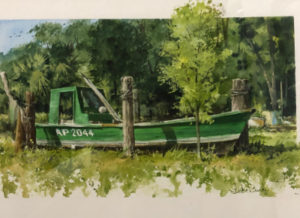
AP 2044 Retired by Luke Buck
In 1929, Joseph Messina, owner of Bay City Packing Company, sold the property to John Herbert Wilson, who built the original one-story structure running it as a “juke joint.” Located at a discrete distance from the café, tea room and economy store, Wilson’s Juke may have served some of the passengers from the train. It was definitely the favorite haunt of local seafood workers and the roustabouts of the neighborhood. The bar, noted for its pool room and gambling, was infamously known as the “Bloody Bucket.”Wilson sold the property to Carrie Lee Rogers Ross in 1941. The Ross family were seafood industry workers. Sons, Arthur and Willie Smith, grew up in the house and played in the neighborhood with descendants of John and Constantine Nichols. Many locals have fond memories of this period in the 1960s and 70s.
There is a tin shed at the rear of the property underneath an enormous live oak. Arthur tells us that in the 1940s his grandfather, Froggy Ross, had a fish market in the shed where he sold his catch. On the adjoining lot, Frog Ross had a vineyard and fruit trees, as well as free range chickens. Percy and Piggy Vause, sons of family friend, Neil Vause, would collect the grapes and sell them to neighbor Ignatius Brocato, who made scuppernong wine* from the grapes harvested in this downtown vineyard.
More recently, this was home to Christo Poloronis, who was born in Apalachicola in 1933. He spent his last years here, prior to his death on November 2, 2014. He was beloved by the town, and this house is well-known among locals as “Christo’s House.” According to his obituary in the Apalachicola Times:
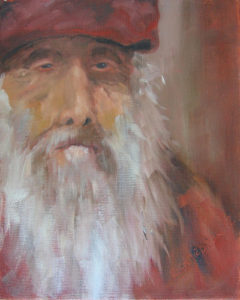
Christo Old Salt by Susan Richardson
“He retired after 20 years with the Florida National Guard. He was a plumber and builder, and held many other jobs, including that of city commissioner. Other positions he held were at the county courthouse, the city of Apalachicola’s housing complex and, for many years, at Taranto Fish House. Christo was very pleasant to talk with, and recalled much of the history of things going on around Apalachicola from his youth and onwards. He was well-known for his love of stray cats, known by many as ‘the cat man,’ and for riding his bicycle all over Apalachicola.”
It is said Christo was a quite a sight to see riding on his bicycle with his long white beard flowing; often followed by a large flock of seagulls.
* Scuppernong is a thick-skinned, white-wine grape found in the southeastern United States. It is the earliest named variety of the Muscadine grape and has become another name for all muscadine grapes. Muscadines are wild, and they taste like it. The inner flesh is rich and thick with an intense sweetness, and the fruit has tough spicy skins that taste like plums. They were one of the first types of grapes used to make wine in the United States, and some people still make homemade wine from the muscadine and scuppernong vines ranging over their back lots.

